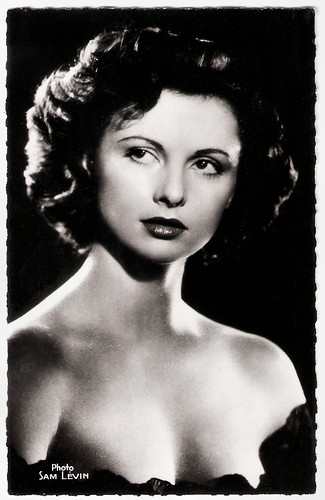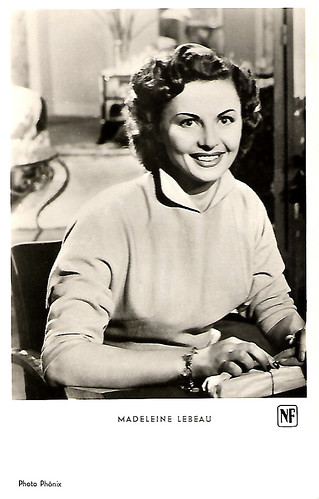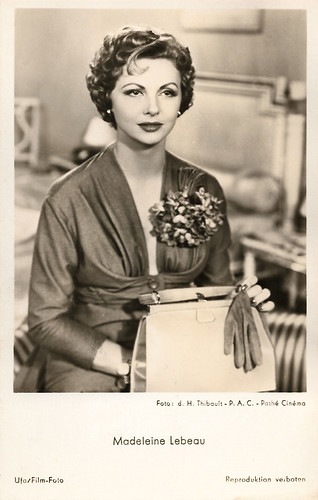French stage and film actress Madeleine Lebeau (1923-2016) is best remembered as Yvonne in the classic Casablanca (1942), passionately singing 'La Marseillaise' with a tear-stained face. After the war, she had a respectable career in European cinema and portrayed a temperamental actress named Madeleine in another highlight, Federico Fellini's 8 1/2 (1963).

French postcard by Editions du Globe, no. 194. Photo: Sam Lévin.

French autograph card.
Marie Madeleine Berthe LeBeau was born in Antony, Hauts-de-Seine, France, in 1923 (some sources say 1921). In her teens, she landed a tiny role in a play with Marcel Dalio, who was about 20 years her senior and struck by her beauty. They soon married. As Madeleine Lebeau she made her screen debut in the drama, Jeunes filles en détresse/Young Girls in Trouble (Georg Wilhelm Pabst, 1939).
In 1940, she fled Nazi-occupied France with Dalio. They left Paris just hours ahead of the invading German army; Dalio’s image had been used in Nazi posters to identify Jewish-looking features. They made their way to Lisbon and, using what turned out to be forged Chilean visas, booked passage on a Portuguese cargo ship, the Quanza, that was taking more than 300 refugees to the west. Dalio and Lebeau eventually obtained temporary Canadian passports and ended up in the US. Due to Dalio’s connections in Hollywood with fellow French exiles such as Jean Renoir and Charles Boyer, they were both given Warner Bros contracts.
Lebeau made her Hollywood debut with a small part in Hold Back the Dawn (Mitchell Leisen, 1941), which starred Charles Boyer and Olivia de Havilland. The following year, she appeared as glamorous Polish-born stage star Anna Held, the wife of Florenz Ziegfeld, in the Errol Flynn drama Gentleman Jim (Raoul Walsh, 1942), a biography of Irish-American boxer James J. Corbett.
With Marcel Dalio, she appeared in the classic Casablanca (Michael Curtiz, 1942). Lebeau played Yvonne, the French pushed-aside mistress of Rick Blaine, the owner of Rick’s Café Américain (Humphrey Bogart). Neglected by Rick, a drunken Yvonne steps out with a German soldier, but she regains her moral compass. Wikipedia: “Lebeau's best moments in Casablanca are during the scene when French nationals sing ‘The Marseillaise’ drowning out the group of German soldiers singing a German folk song. The camera captures the (genuine) tears on her face, and later, at the end of the anthem, when she cries out Vive la France. France had fallen to Nazi forces, and many of the actors performing in the scene were real life refugees from Europe”.Not long after finishing Casablanca, the then 19-year-old Lebeau and Dalio divorced. He filed suit, claiming desertion. Lebeau hoped Casablanca would catapult her to great demand in Hollywood. It did not.
As a freelancer, she earned supporting roles in the French underground drama Paris After Dark (Léonide Moguy, 1943) with George Sanders and Philip Dorn (Frits van Dongen) and her former husband. The film portrays the activities of the French resistance in Nazi-occupied Paris. Lebeau played a cafe owner who is secretly helping the resistance. Ronald Bergan in The Guardian: “Besides brilliantly handling dramatic scenes, one with a slimy collaborator played by Dalio (they were then on the verge of a divorce), LeBeau, who had a fine singing voice, delivered a soulful ballad, My Paree.” The following year, Lebeau had a smaller role in the musical comedy Music for Millions (Henry Koster, 1944), starring Margaret O'Brien. The film was nominated for an Academy Award in 1946. She also appeared on Broadway in the play 'The French Touch', directed by René Clair.

German postcard by Kunst und Bild, Berlin, no. A 787. Photo: Phönix / NF. Publicity still for Dupont Barbès/Sins of Paris (Henri Lepage, 1951).

German postcard by Ufa/Film-Foto, Berlin-Tempelhof, no. FK 683. Photo: d. H. Thibault / P.A.C. / Pathé Cinéma. Publicity still for Quai des blondes (Paul Cadéac, 1954).
After the war, Madeleine Lebeau returned to Europe and appeared in 20 more films. These included Les Chouans/The Royalists (Henri Calef, 1947) and the English drama Cage of Gold (Basil Dearden, 1950) starring Jean Simmons. Lebeau had a rare leading role in Dupont Barbès/Sins of Madeleine (Henri Lepage, 1951), about a prostitute who uses the ruse of pregnancy to end relationships with men, only to find one of her clients is delighted at the prospect of being a father.
She was in the all-star cast of Sacha Guitry’s Napoleon (1955) and appeared in the bedroom farce Une Parisienne (Michel Boisrond, 1957) as Brigitte Bardot’s romantic rival. In 1956, she married a young businessman, Marcel Guez, but the marriage ended three years later in a divorce.
In Federico Fellini's classic Otto e mezzo/8½ (1963), she played a French actress named Madeleine, one of the former loves of Guido Anselmi (Marcello Mastroianni).
During the 1960s, she also appeared in the Spaghetti Western Desafío en Río Bravo/Gunmen of the Rio Grande (Tulio Demicheli, 1964) with Guy Madison and Angélique, marquise des anges/Angélique (Bernard Borderie, 1964), the first of the Angélique cycle starring Michèle Mercier. Lebeau's film career ended with the Spanish production La vuelta/The Return (José Luis Madrid, 1965). Her last turn before the cameras came in the French television series Allô police/Hello, Police (1969-1970).
After the filming of Otto e mezzo/8½ (Federico Fellini, 1963), she stayed in Rome. In 1988, she married Italian screenwriter Tullio Pinelli, who had co-written 8 1/2. He passed away in 2009 at 100. After the death of her husband, Madeleine Lebeau moved to Estepona in the south of Spain. There, she died in 2016 from complications following breaking her thigh bone. She was 92. A daughter, Maria Duhour Gil, survived her.

East-German postcard by VEB Progress Film-Vertrieb, Berlin, no. 1431. Photo: Publicity still for La Picara Molinera/The Miller's Saucy Wife (Léon Klimovsky, 1955).
Scene from Casablanca (1942). Source: myyouyou111 (YouTube).
Sources: Ronald Bergan (The Guardian), Adam Bernstein (Washington Post), William Grimes (The New York Times), Frances D’Emilio and Lindsey Bahr (The Globe and Mail), Tom B. (Westerns...All'Italiana!), CineMemorial (Now defunct), BBC, Wikipedia and IMDb.
This post was last updated on 9 March 2025.

French postcard by Editions du Globe, no. 194. Photo: Sam Lévin.

French autograph card.
Warner Bros
Marie Madeleine Berthe LeBeau was born in Antony, Hauts-de-Seine, France, in 1923 (some sources say 1921). In her teens, she landed a tiny role in a play with Marcel Dalio, who was about 20 years her senior and struck by her beauty. They soon married. As Madeleine Lebeau she made her screen debut in the drama, Jeunes filles en détresse/Young Girls in Trouble (Georg Wilhelm Pabst, 1939).
In 1940, she fled Nazi-occupied France with Dalio. They left Paris just hours ahead of the invading German army; Dalio’s image had been used in Nazi posters to identify Jewish-looking features. They made their way to Lisbon and, using what turned out to be forged Chilean visas, booked passage on a Portuguese cargo ship, the Quanza, that was taking more than 300 refugees to the west. Dalio and Lebeau eventually obtained temporary Canadian passports and ended up in the US. Due to Dalio’s connections in Hollywood with fellow French exiles such as Jean Renoir and Charles Boyer, they were both given Warner Bros contracts.
Lebeau made her Hollywood debut with a small part in Hold Back the Dawn (Mitchell Leisen, 1941), which starred Charles Boyer and Olivia de Havilland. The following year, she appeared as glamorous Polish-born stage star Anna Held, the wife of Florenz Ziegfeld, in the Errol Flynn drama Gentleman Jim (Raoul Walsh, 1942), a biography of Irish-American boxer James J. Corbett.
With Marcel Dalio, she appeared in the classic Casablanca (Michael Curtiz, 1942). Lebeau played Yvonne, the French pushed-aside mistress of Rick Blaine, the owner of Rick’s Café Américain (Humphrey Bogart). Neglected by Rick, a drunken Yvonne steps out with a German soldier, but she regains her moral compass. Wikipedia: “Lebeau's best moments in Casablanca are during the scene when French nationals sing ‘The Marseillaise’ drowning out the group of German soldiers singing a German folk song. The camera captures the (genuine) tears on her face, and later, at the end of the anthem, when she cries out Vive la France. France had fallen to Nazi forces, and many of the actors performing in the scene were real life refugees from Europe”.Not long after finishing Casablanca, the then 19-year-old Lebeau and Dalio divorced. He filed suit, claiming desertion. Lebeau hoped Casablanca would catapult her to great demand in Hollywood. It did not.
As a freelancer, she earned supporting roles in the French underground drama Paris After Dark (Léonide Moguy, 1943) with George Sanders and Philip Dorn (Frits van Dongen) and her former husband. The film portrays the activities of the French resistance in Nazi-occupied Paris. Lebeau played a cafe owner who is secretly helping the resistance. Ronald Bergan in The Guardian: “Besides brilliantly handling dramatic scenes, one with a slimy collaborator played by Dalio (they were then on the verge of a divorce), LeBeau, who had a fine singing voice, delivered a soulful ballad, My Paree.” The following year, Lebeau had a smaller role in the musical comedy Music for Millions (Henry Koster, 1944), starring Margaret O'Brien. The film was nominated for an Academy Award in 1946. She also appeared on Broadway in the play 'The French Touch', directed by René Clair.

German postcard by Kunst und Bild, Berlin, no. A 787. Photo: Phönix / NF. Publicity still for Dupont Barbès/Sins of Paris (Henri Lepage, 1951).

German postcard by Ufa/Film-Foto, Berlin-Tempelhof, no. FK 683. Photo: d. H. Thibault / P.A.C. / Pathé Cinéma. Publicity still for Quai des blondes (Paul Cadéac, 1954).
Federico Fellini
After the war, Madeleine Lebeau returned to Europe and appeared in 20 more films. These included Les Chouans/The Royalists (Henri Calef, 1947) and the English drama Cage of Gold (Basil Dearden, 1950) starring Jean Simmons. Lebeau had a rare leading role in Dupont Barbès/Sins of Madeleine (Henri Lepage, 1951), about a prostitute who uses the ruse of pregnancy to end relationships with men, only to find one of her clients is delighted at the prospect of being a father.
She was in the all-star cast of Sacha Guitry’s Napoleon (1955) and appeared in the bedroom farce Une Parisienne (Michel Boisrond, 1957) as Brigitte Bardot’s romantic rival. In 1956, she married a young businessman, Marcel Guez, but the marriage ended three years later in a divorce.
In Federico Fellini's classic Otto e mezzo/8½ (1963), she played a French actress named Madeleine, one of the former loves of Guido Anselmi (Marcello Mastroianni).
During the 1960s, she also appeared in the Spaghetti Western Desafío en Río Bravo/Gunmen of the Rio Grande (Tulio Demicheli, 1964) with Guy Madison and Angélique, marquise des anges/Angélique (Bernard Borderie, 1964), the first of the Angélique cycle starring Michèle Mercier. Lebeau's film career ended with the Spanish production La vuelta/The Return (José Luis Madrid, 1965). Her last turn before the cameras came in the French television series Allô police/Hello, Police (1969-1970).
After the filming of Otto e mezzo/8½ (Federico Fellini, 1963), she stayed in Rome. In 1988, she married Italian screenwriter Tullio Pinelli, who had co-written 8 1/2. He passed away in 2009 at 100. After the death of her husband, Madeleine Lebeau moved to Estepona in the south of Spain. There, she died in 2016 from complications following breaking her thigh bone. She was 92. A daughter, Maria Duhour Gil, survived her.

East-German postcard by VEB Progress Film-Vertrieb, Berlin, no. 1431. Photo: Publicity still for La Picara Molinera/The Miller's Saucy Wife (Léon Klimovsky, 1955).
Scene from Casablanca (1942). Source: myyouyou111 (YouTube).
Sources: Ronald Bergan (The Guardian), Adam Bernstein (Washington Post), William Grimes (The New York Times), Frances D’Emilio and Lindsey Bahr (The Globe and Mail), Tom B. (Westerns...All'Italiana!), CineMemorial (Now defunct), BBC, Wikipedia and IMDb.
This post was last updated on 9 March 2025.
No comments:
Post a Comment